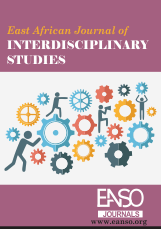Awareness and Utilisation of Solar Food Drying Technology in Zambia: A Case Study of Traders of Dried Fruits and Vegetables at Lusaka City and Soweto Markets
Abstract
This research was set out to explore the levels of awareness and utilisation of solar food drying technology in Zambia. The overall research problem addressed was that despite the availability of solar food drying technology, which could reduce the current high post-harvest losses of fruits and vegetables, the technology was not widely used on a commercial basis in Zambia. To achieve the objectives, both quantitative and qualitative data were collected from three sets of populations, namely, traders of dried fruits and vegetables at Lusaka City and Soweto Markets, ordinary people on the streets of Lusaka, and supermarkets that sold dried fruits and vegetables. The research findings have indicated the following: 1) the main method of drying for the dried vegetables sold at Lusaka City and Soweto Markets was open sun drying; 2) almost all the traders of dried vegetables at Lusaka City and Soweto Markets were not aware of solar food drying technology; 3) there exists a market for dried vegetables at Lusaka City and Soweto Markets and Pumpkin leaves was the most traded vegetable; and 4) local people from the streets of Lusaka were interested in dried vegetables but did not buy dried fruits. It was concluded that the low utilisation of solar food drying technology was due to a lack of information about what the technology does and its benefits to potential users, such as traders and farmers of fruits and vegetables. This implies that Zambia may not fully utilise the opportunities that are currently available to export dried fruits and vegetables due to limitations of the open sun drying method that is currently widely used. The situation, therefore, requires drastic measures from both the Government and the Private Sector to disseminate solar food drying technology
Downloads
References
Adamo, A., Martín, H., Hoz, J. D. L., & Rubio, J. (2025). A review of worldwide strategies for promoting high-temperature heat pumps. Applied Sciences, 15(2), 839.
Binge, B., Jalango, D., & Tesfaye, L. (2023). Post-harvest losses management through climate smart innovations: A collaborative approach among value chain actors.
Cairns, R., Onyango, J., Stirling, A., & Johnstone, P. (2022). Imagining urban transformation in Kenya. Environmental Science & Policy, 135, 86–95.
Karlsson, A. (2022). Low cost thermal storage for solar dryers in the Himalayas.
Kaimal, A. M., Tidke, V. B., Mujumdar, A. S., & Thorat, B. N. (2022). Food security and sustainability through solar drying technologies: A case study based on solar conduction dryer. Materials Circular Economy, 4, 1–23.
Kimaro, B. J., Kilonzo, R. G., & Matunga, B. N. (2024). Analysis of co operative irrigation farming and household food security in Africa.
Lin, S. T. (2023). Understanding the social well-being of migrant women in the dried fish value chain: A study in Samut Sakhon Province, Thailand (Doctoral dissertation, Asian Institute of Technology).
Maendeleo Agricultural Technology Fund. (2011). Post-harvest handling and marketing of perishable agricultural products using solar dryers in Mbarara District, Uganda.
Mbewe, M., Kalikeka, M., Phiri, J., Masilokwa, I., Mwimba, T., Mungu, M., … Commodore, R. (2025). Country Economic Transformation Outlook (CETO) 2025.
Mirembe, A., Nakiirya, R., & Kansiime, M. K. (2024). Demonstration of the potential use of off-grid renewable energy in agricultural production in rural Uganda. Open Research Europe, 4(150), 150.
Musonda, L., & Mwila, N. (2024). Factors influencing post-harvest losses of fresh tomato in the distribution channel in Lusaka markets. African Journal of Commercial Studies, 4(2), 104–112.
Nguni, D., & Mwila, G. (2007). Opportunities for increased production, utilization and income generation from African leafy vegetables in Zambia. African Journal of Food, Agriculture, Nutrition and Development, 7(4), 1-20.
Oniang’o, R., Maingi, Z., Jaika, S., & Konyole, S. (2025). Africa’s contribution to global sustainable and healthy diets: A scoping review. Frontiers in Nutrition, 12, 1519248.
Rohith, S. (2021). An investigation into the hygiene practices and food safety of street vendors outside pension pay out points in urban poor communities in the City of Cape Town (Doctoral dissertation, Stellenbosch University).
Rutta, E. W. (2022). Barriers impeding the deployment and uptake of solar-powered cold storage technologies for postharvest loss reduction in tomato value chain in Africa: Empirical evidence from Tanzania (Doctoral dissertation, Queen’s University, Canada).
Simate, I. N., & Ahrné, L. M. (2006). Dehydration of Tropical Fruits. In: Handbook of Food Technology and Food Engineering. Editor: Y. H. Hui. Publisher: Marcel Dekker. 104-1 – 104-18. https://doi.org/10.1201/b15995-116
Wanjohi, E. A. (2010). Solar dryer as a technological tool for income generation Part II: The case of Embu District. Home Economics for Rural Development, (5), 30–32.
Copyright (c) 2025 Isaac Nyambe Simate

This work is licensed under a Creative Commons Attribution 4.0 International License.




























